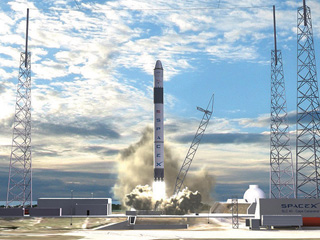 Rocket: Falcon 9 Payload: Dragon Date: June 4, 2010 Window: 11 a.m.-3 p.m. EDT Site: SLC-40, Cape Canaveral, Florida 

|
Mission Status Center
Welcome to Spaceflight Now's live coverage of the inaugural Falcon 9 rocket launching a Dragon test unit on a demonstration flight. Text updates will appear automatically; there is no need to reload the page. Follow us on Twitter. SUNDAY, MARCH 14, 2010
SpaceX has released a few pictures from remote cameras at the launch pad showing Saturday's on-pad engine test. The nine engines ignited at 12:30 p.m. EST (1730 GMT). All photos are by Chris Thompson of SpaceX.
0630 GMT (1:30 a.m. EST) See the photo gallery. SATURDAY, MARCH 13, 2010
SpaceX successfully fired the Falcon 9 rocket's nine Merlin engines on a Florida launch pad Saturday, completing a key preflight test before the privately-developed booster is cleared for launch in April.
2355 GMT (6:55 p.m. EST) The 15-story rocket's first stage engines ignited at 12:30 p.m. EST (1730 GMT), sending a plume of smoke out of the flame trench at Cape Canaveral's Complex 40. The nine engines ramped up to more than 800,000 pounds of thrust and burned for a handful of seconds, meeting all the company's test objectives, according to SpaceX. "Today, SpaceX successfully completed a test firing of the inaugural Falcon 9 launch vehicle at Space Launch Complex 40 located at Cape Canaveral," the company said in a written statement. "Following a nominal terminal countdown, the launch sequencer commanded ignition of all 9 Merlin first stage engines for a period of 3.5 seconds." Read our full story. 2029 GMT (3:29 p.m. EST)
SpaceX released the following statement this afternoon:
"Today, SpaceX successfully completed a test firing of the inaugural Falcon 9 launch vehicle at Space Launch Complex 40 located at Cape Canaveral. Following a nominal terminal countdown, the launch sequencer commanded ignition of all 9 Merlin first stage engines for a period of 3.5 seconds. "Just prior to engine ignition, the pad water deluge system was activated providing acoustic suppression to keep vibration levels within acceptable limits. The test validated the launch pad propellant and pneumatic systems as well as the ground and flight control software that controls pad and launch vehicle configurations. The completion of a successful static fire is the latest milestone on the path to first flight of the Falcon 9 which will carry a Dragon spacecraft qualification unit to orbit." 1930 GMT (2:30 p.m. EST)
Venting from the Falcon 9 rocket has stopped as SpaceX finishes draining the booster's propellant tanks.
1810 GMT (1:10 p.m. EST)
This will conclude our live stream of today's test. Unfortunately, suitable camera angles were blocked from the public's view during this critical milestone for the Falcon 9 rocket.
1733 GMT (12:33 p.m. EST)
Visual indications are the Merlin engines ignited during today's static fire attempt. The engines were supposed to burn for 3.5 seconds.
1730 GMT (12:30 p.m. EST)
IGNITION. The Falcon 9 rocket's nine Merlin engines have fired for a brief test at Complex 40.
1729 GMT (12:29 p.m. EST)
STANDING BY FOR IGNITION. The Falcon 9 rocket's propellant tanks are being pressurized in the final minute of the countdown, a sign engine ignition is imminent.
1726 GMT (12:26 p.m. EST)
T-minus 4 minutes and counting, according to countdown clocks.
1719 GMT (12:19 p.m. EST)
The latest information we have indicates the static fire is scheduled for 12:30 p.m. EST. SpaceX is not providing the media or public any updates on the official status.
Critical steps expected to occur in the last 10 minutes of the countdown include the alignment of the internal navigation system, a second stage engine steering check, transferring the rocket to internal power, liquid oxygen system closeouts, and the start of the automated sequence. 1704 GMT (12:04 p.m. EST)
The Falcon 9 rocket's nine Merlin 1C first stage engines will be ignited today for 3.5 seconds, enough time to verify systems on the ground and the launch vehicle responsible for the final few seconds of the countdown.
The engines will produce about 825,000 pounds of total sea level thrust, about four times the power of a 747 jumbo jet at full throttle. The engines consume about 3,200 pounds of kerosene and liquid oxygen propellants per second, according to SpaceX. "This is analogistic to a run-up an aircraft might do on the runway to verify all systems are functional," said Elon Musk, SpaceX's founder and CEO, in a January interview. "That gives the rocket a nice final shakedown. We will then double-check everything to make sure everything's OK after that short static fire. If it's looking good, then we launch soon thereafter." Liftoff is scheduled for no earlier than April 12 during a launch window between 11 a.m. and 3 p.m. EDT. 1700 GMT (12 p.m. EST)
T-minus 30 minutes and counting. The second attempt for the Falcon 9 rocket's static engine test is a half-hour away.
The first try Tuesday was aborted during the ignition sequence due to a stuck valve in ground support equipment. The valve was supposed to open to allow high pressure helium to flow into the rocket to start the engine turbopumps. Weather later in the week kept SpaceX from attempting another hotfire until today. 1645 GMT (11:45 a.m. EST)
Like its first hotfire countdown Tuesday, SpaceX is not providing any real-time status updates on the progress of today's test.
Ignition of the nine Merlin engines is scheduled about 45 minutes from now, according to countdown clocks at Cape Canaveral. The Air Force Eastern Range is supporting today's test activities with SpaceX. Range officials are based in the Range Operations Control Center, or ROCC. "The launch vehicle does not contain all mission elements at this point; however, we will be supporting the static fire with a majority of the Eastern Range interface with SpaceX, which will be scheduling and conducting a Mission Dress Rehearsal as a milestone to launch, as well an Integrated Crew Exercise," an Air Force spokesperson said in a written statement. "The 45th Space Wing continues to work to support range customers like SpaceX to assure access to the high frontier." 1626 GMT (11:26 a.m. EST)
We are now streaming live video of the Falcon 9 rocket at Complex 40. Hit reload and the video window should appear on the right side of this page.
1618 GMT (11:18 a.m. EST)
The Falcon 9 hotfire test remains set for 12:30 p.m. EST (1730 GMT), as the SpaceX launch team continues loading kerosene and liquid oxygen into the rocket.
1540 GMT (10:40 a.m. EST)
Liquid oxygen vapors are flowing from the Falcon 9 rocket, indicating the 154-foot-tall launcher is being loaded with propellant for today's engine test.
The liquid oxygen is stored in a 125,000-gallon sphere in the southeast quadrant of Complex 40. The rocket's RP-1 kerosene fuel is kept in cylinder-shaped tanks on the west side of the pad. Engineers plan to load nearly 39,000 gallons of super cold liquid oxygen and almost 25,000 gallons of kerosene fuel into the first stage tanks. About 7,300 gallons of liquid oxygen and 4,600 gallons of kerosene will go into the second stage. The propellants flow into the first stage through the launch mount at the base of the rocket. Kerosene and liquid oxygen will be pumped up the strongback umbilical tower to enter the second stage. A team of about 30 engineers and managers is stationed inside the SpaceX Launch Control Center near the south gate of Cape Canaveral Air Force Station. 1445 GMT (9:45 a.m. EST)
At Cape Canaveral's Complex 40, the stongback structure is beginning to move away from the Falcon 9 rocket in preparation for today's fueling and test-firing of the nine Merlin main engines. Countdown clocks are targeting an ignition time of 12:30 p.m. EST (1730 GMT).
A reminder that if you will be away from your computer but would like to receive occasional countdown updates, sign up for our Twitter feed to get text message updates on your cellphone. U.S. readers can also sign up from their phone by texting "follow spaceflightnow" to 40404. (Standard text messaging charges apply.) FRIDAY, MARCH 12, 2010
SpaceX did not attempt another static fire this afternoon. Rain fell throughout the day at Cape Canaveral.
2310 GMT (6:10 p.m. EST) 1740 GMT (12:40 p.m. EST)
It is a cloudy, damp day on the Space Coast. Steady rain has been passing over the Falcon 9 rocket all morning, and more showers are expected this afternoon.
SpaceX could light the rocket's nine main engines some time this afternoon, but so far there is no obvious sign of fueling activity at Complex 40. Exactly when the company will attempt another engine test is unknown, but weather Saturday is forecast to be much improved. THURSDAY, MARCH 11, 2010
Elon Musk, SpaceX's founder and CEO, has provided the following update on the cause of Tuesday's aborted launch pad engine test:
2205 GMT (5:05 p.m. EST) "The valve that didn't actuate is the ground side isolation valve to release ground supplied high pressure helium to start the first stage engine turbopumps spinning at several thousand rpm. Once that happens it generates enough pressure to start the gas generator, which is a small rocket engine that powers the turbopump. There are no vehicle side valves actuated for spin start (just check valves), so it is an all engines or none situation. The problem was pretty simple: our autostart sequence didn't issue the command to the normally closed ground side isolation valve. We had tested everything on the vehicle side exhaustively in Texas, but didn't have this iso valve on our test stand there. Definitely a lesson learned to make sure that *everything* is the same between test stand and launch pad on the ground side, not just on the vehicle side. Ignition fluid (TEA-TEB) flowed nominally to all engines creating the green flame and the main valves opened, but no engines actually started and the system automatically aborted on lack of spin. The fire generated was from flushing the system of fuel and LOX from the open mains. No damage to the vehicle or ground systems and no other anomalies that need to be addressed. If all goes well, we will try the static fire again in the next few days. Right now, we are holding due to extreme weather. It is raining sideways at 46 mph and tornados have been spotted just north of the Cape. It is important for readers to appreciate that what we are going through right now is the equivalent of "beta testing." Problems are expected to occur, as they have throughout the development phase. The beta phase only ends when a rocket has done at least one, but arguably two or three consecutive flights to orbit." 2140 GMT (4:40 p.m. EST)
SpaceX is planning April 12 as their new launch date on the Eastern Range, according to the Air Force. The launch window would be between 11 a.m. and 3 p.m. EDT. But the new launch date is still pending Air Force approval.
The company tried to fuel the 15-story Falcon 9 rocket this afternoon and fire the first stage's nine Merlin engines for a hotfire test, but inclement weather thwarted the attempted test. The weather forecast tomorrow calls for similar conditions to today, including a good chance of strong thunderstorms near Cape Canaveral. The outlook predicts better weather Saturday and Sunday. 1935 GMT (2:35 p.m. EST)
A SpaceX spokesperson says today's engine test has been scrubbed due to winds and weather at the launch site.
1925 GMT (2:25 p.m. EST)
Amid thunder, heavy rain and stiff winds, the Falcon 9 remains on the launch pad. The strongback servicing tower has been returned to its vertical position against the Falcon 9 rocket. SpaceX officials still aren't confirming whether there is still a chance of a static fire attempt this afternoon.
1720 GMT (12:20 p.m. EST)
The strongback fueling tower has retracted away from the Falcon 9 rocket at Cape Canaveral. Whether this activity is a test or a sign that the booster will soon be fueled is unclear. The latest information we received from SpaceX indicated the static fire may occur today, but stormy weather is prevalent across the Space Coast.
1415 GMT (9:15 a.m. EST)
SpaceX could attempt another static fire this afternoon, but that is a "big maybe," company officials say. Scattered showers and thunderstorms are passing across Central Florida today, but the impact of weather on the Falcon 9 rocket's engine test is unclear.
The strongback will be partially retracted away from the rocket before fueling occurs. Read our earlier status center coverage. |
 The Falcon 9 rocket will launch on a test flight. See our photo galleries: Rocket assembly inside hangar | Falcon on the pad | Engines fire for test | Rollout before launch  
Space video for your computer, iPod or big screen TV
Experience the space program like never before become a subscriber today |